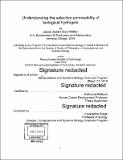Understanding the selective permeability of biological hydrogels
Author(s)
Witten, Jacob Julian Seid.
Download1124074546-MIT.pdf (22.97Mb)
Other Contributors
Massachusetts Institute of Technology. Computational and Systems Biology Program.
Advisor
Katharina Ribbeck.
Terms of use
Metadata
Show full item recordAbstract
Biological hydrogels are fundamental to life, from microbial biofilms to mucus and the nuclear pore in humans. These hydrogels exhibit complex selective permeability behavior, allowing the passage of some particles while blocking the penetration of others. This selective permeability is critical for understanding the biological and medicinal impact of mucus, which coats all non-keratinized epithelia in the body. Mucus controls the penetration of microbes, pollutants, and nanoparticles through a combination of steric and interactive (binding-based) constraints. For small molecules, binding to mucus and in particular mucin, the main gel-forming component of mucus, affects diffusive permeability and may also affect a molecule's biological or therapeutic activity. However, the molecular characteristics leading to mucus binding are not well understood. I therefore developed a mucus binding assay with substantially greater throughput than any existing assay, and combined it with a mucin binding screen to identify a new motif as associated with binding to mucin. I also validate the link between binding to mucin and reduced activity in mucin for the antibiotic colistin. Next, I applied my binding technique to study the binding of a wide range of antibiotics and inhaled drugs to respiratory mucus, and identified previously unknown mucus binding interactions. These binding interactions could impact the activity of the drugs within the mucus or impact their lung residence time in the case of highly muco-obstructive lung diseases. The nuclear pore, which controls the passage of material between the nucleus and the cytoplasm, is similar to mucus in that it too is a selectively permeable network of disordered proteins. Passage through the nuclear pore requires interaction with the network that was initially thought to be purely hydrophobic in character. However, there is evidence that electrostatic interactions also partly govern nuclear pore transport. Here, we apply a peptide-based system to study the interplay of hydrophobic and electrostatic interactions to further dissect the biochemistry underlying nuclear pore function.
Description
Thesis: Ph. D., Massachusetts Institute of Technology, Computational and Systems Biology Program, 2019 Cataloged from PDF version of thesis. Includes bibliographical references (pages 148-160).
Date issued
2019Department
Massachusetts Institute of Technology. Computational and Systems Biology ProgramPublisher
Massachusetts Institute of Technology
Keywords
Computational and Systems Biology Program.